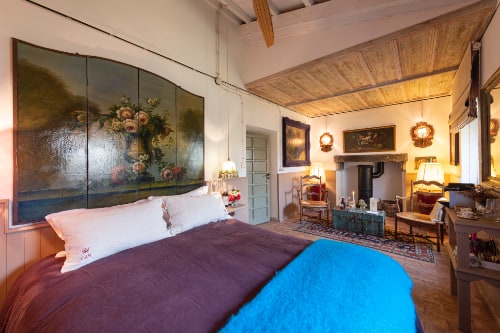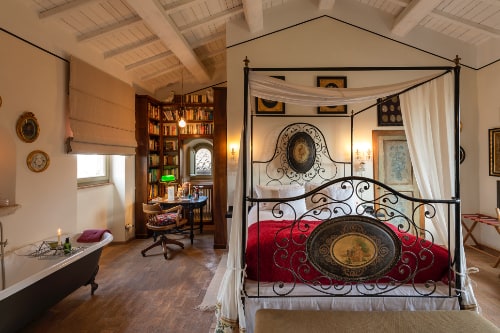Corte della Maestà: An Enchanting Italian Mountain Retreat Embracing ‘Dolce Far Niente’
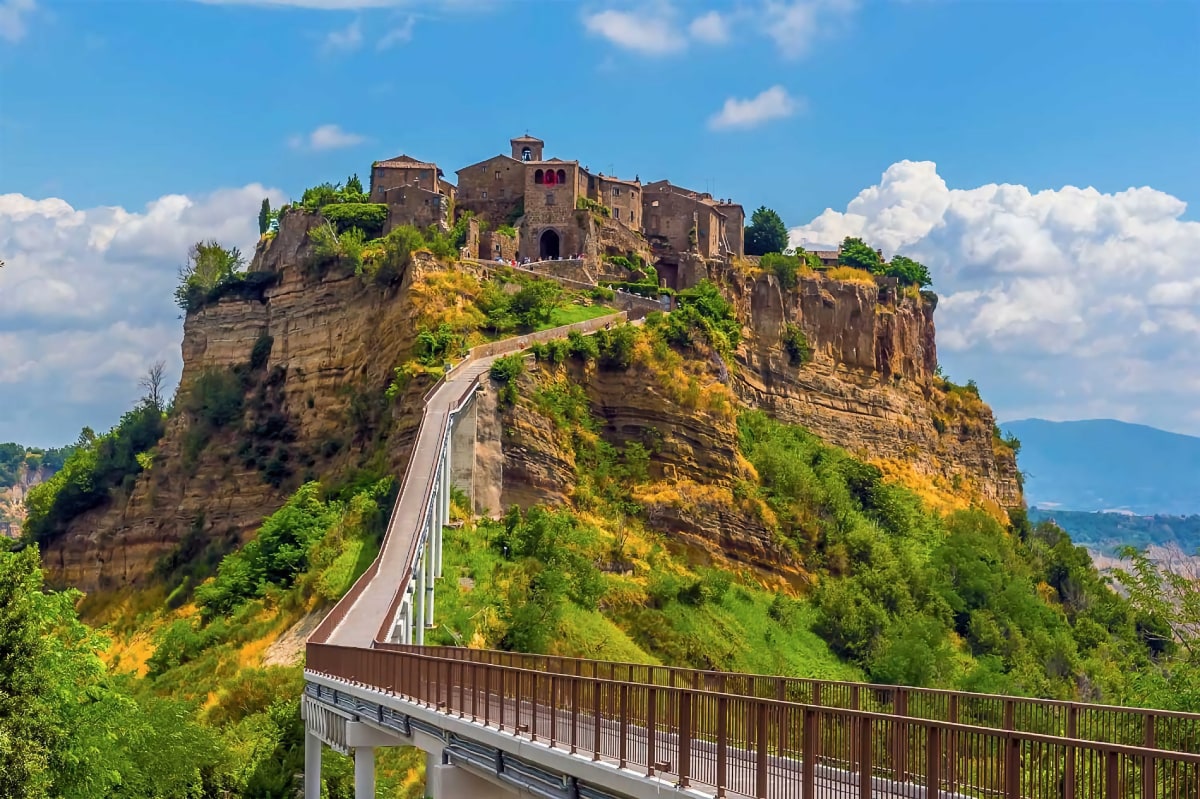
by Laura Goldstein
Photos: Giovanni De Sandre Studio GDS
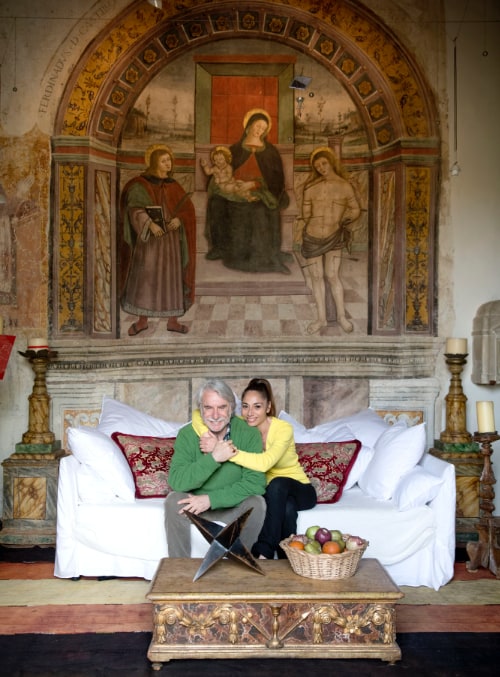 The bridge looks daunting but chalk it up to part of the adventure. Iron Man and Iron Woman we are not so the spectacular views of Italy’s Calanchi Valley serve to distract us as we trudged along the modern and very busy 300-metre pedestrian – only bridge ascending almost vertically into the teetering medieval mountain town of Civita di Bagnoregio, about 90 minutes from Rome. A little truck ferries luggage up and down the bridge, much to our relief. From afar, a film set is our first impression. Surely this can’t be real – as we time travel back to the Etruscan village built 2,500 years ago sculpted on volcanic rock perched atop the mountain. An earthquake devastated the hamlet in 1695, and today, though only eleven people live in the village full time, it’s attracted adventurous tourists beguiled by the bridge and the elegant Corte della Maestà. Entering through the ancient stone archway, every step is history. Narrow cobblestone passageways and walls festooned with climbing roses meander off the main piazza, a dizzying maze to the uninitiated. Having just come from the teaming crowds in Rome, we crave ‘dolce far niente’ slowing down to enjoy the beauty and sweetness of doing nothing. Our charming host and hotel manager, Cristiana Melis is waiting and leads us through a hidden leafy wooden door that opens into Corte della Maestà (Court of Majesty.)
The bridge looks daunting but chalk it up to part of the adventure. Iron Man and Iron Woman we are not so the spectacular views of Italy’s Calanchi Valley serve to distract us as we trudged along the modern and very busy 300-metre pedestrian – only bridge ascending almost vertically into the teetering medieval mountain town of Civita di Bagnoregio, about 90 minutes from Rome. A little truck ferries luggage up and down the bridge, much to our relief. From afar, a film set is our first impression. Surely this can’t be real – as we time travel back to the Etruscan village built 2,500 years ago sculpted on volcanic rock perched atop the mountain. An earthquake devastated the hamlet in 1695, and today, though only eleven people live in the village full time, it’s attracted adventurous tourists beguiled by the bridge and the elegant Corte della Maestà. Entering through the ancient stone archway, every step is history. Narrow cobblestone passageways and walls festooned with climbing roses meander off the main piazza, a dizzying maze to the uninitiated. Having just come from the teaming crowds in Rome, we crave ‘dolce far niente’ slowing down to enjoy the beauty and sweetness of doing nothing. Our charming host and hotel manager, Cristiana Melis is waiting and leads us through a hidden leafy wooden door that opens into Corte della Maestà (Court of Majesty.)
If the literary classic, The Secret Garden enchanted you as a child, Corte della Maestà’s walled enclave with its towering arbours and olive trees, potted blue hydrangeas and hidden statuary will captivate all your senses as an adult.
“I discovered Civita almost 30 years ago visiting a patient of mine. It’s constructed like a dream but it’s not a hermitage, it’s an emotional experience,” explains owner, Paolo Crepet, a well known Italian psychiatrist, author and TV personality. With his wife, Cristiana Melis they have spent decades renovating the chic antique-filled property, a former 14th century bishop’s palace transformed into a boutique hotel. They met years ago when she was an arts publicist for an exhibition of Federico Fellini’s illustrations for many of his legendary films. In fact, one of the hotel’s first guests was film director, Giuseppe Tornatore who won an Oscar for the heartfelt masterpiece, Cinema Paradiso and a long-time friend of Crepet.
Their mutual love of the arts, scouring antique and flea markets, Crepet’s passion for auctions and Melis’ intrinsic ability to make everything homey yet exquisite at the same time, (she should have been an interior designer,) makes our stay the highlight of our 25th wedding anniversary trip to Italy.
All four bedroom suites are stunning. Resembling Old Master still life paintings, each harbours its own treasures and fascinating back-stories that Melis has conceptualized with antiques mixed with contemporary furnishings.
It’s no coincidence that we are staying in La Scrittrice (The Writer) suite with its own private entrance off the garden. The cabbage rose patterned wallpaper in the sitting room mimics the rose clustered pergola outside and is a reproduction found in Virginia Woolf’s London home as is the antique writing desk. An original 16th century fresco has been left untouched on the wall of the cosy bedroom and a wrought iron headboard towers over strewn plump pillows. The bed is topped with a chartreuse mohair blanket for chilly nights (a different colour in each suite,) that Melis imported from New Zealand. Her penchant for antique portrait paintings mostly of women, decorate the walls.
The Abbess Suite that opens onto a little balcony, takes its name from the ornate wrought iron four poster bed frame that once belonged to the abbess of a monastery. It’s a tribute to the book, The Abbess of Castro by Renaissance writer Stendhal. An early 19th century French oak fireplace and iron bathtub compliment the room.
A vision in gold with ornate headboard acquired from a 19th century theatrical production, The Sleepwalker Suite is an homage to the theatre and to Italy’s grand tradition of opera while The Intruder Suite looks out through windows over the valley and the house of the late Argentine poet and writer, Rodolfo Wilcock, a great friend of Jorge Luis Borges.
Unusual wall sconces, beaded lamps and gilded mirrors cast and reflect shadows on the ancient stone walls of each suite.
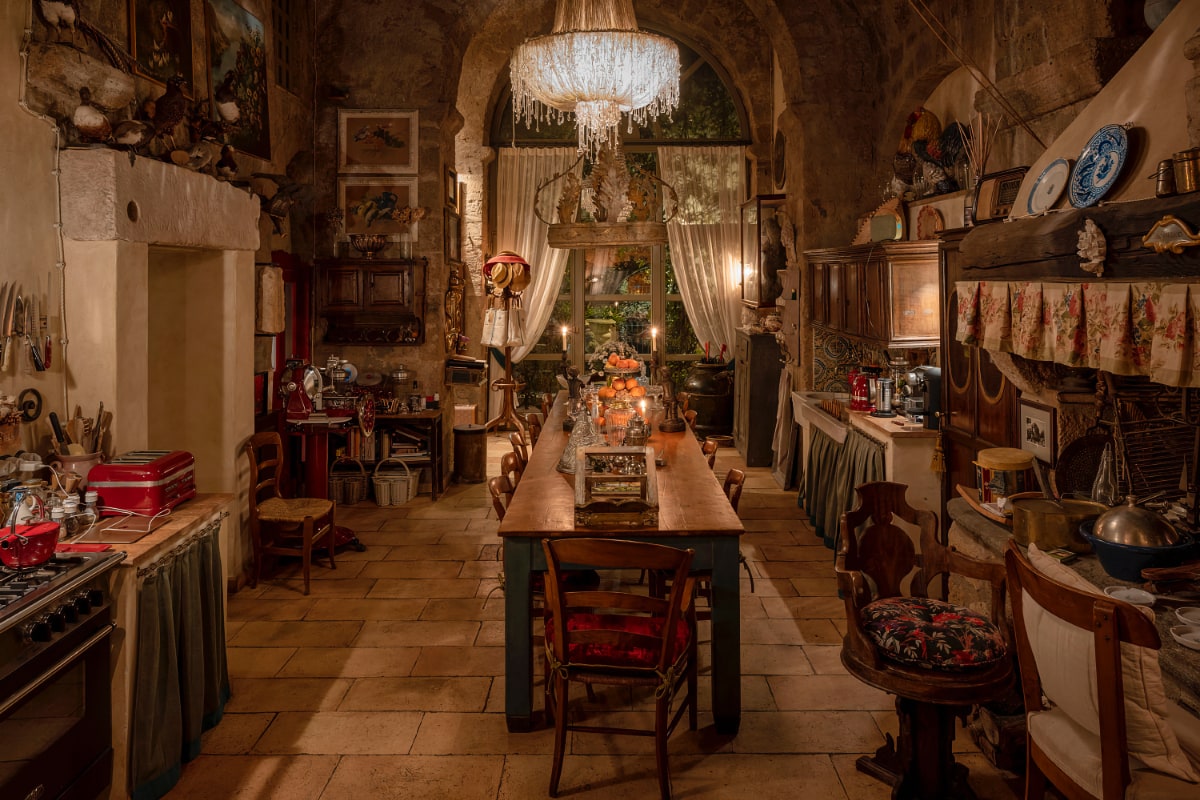
Entering the kitchen, it’s hard to know where to look first as it overlooks an immense garden planted with fig, persimmon and lemon trees. A crystal chandelier from Brussels circa 1930’s dominates the vaulted stone ceiling, antique copper dessert molds adorn blue Italian tiled walls and beautiful serving pieces from France are everywhere. They all reflect Melis’ obsession for brocantage, the art of vintage collecting. “It’s been a passion of mine since I was a girl,” she confides. “It was so much fun visiting second-hand dealers and flea markets in France and Italy looking for unusual objects and treasures.”
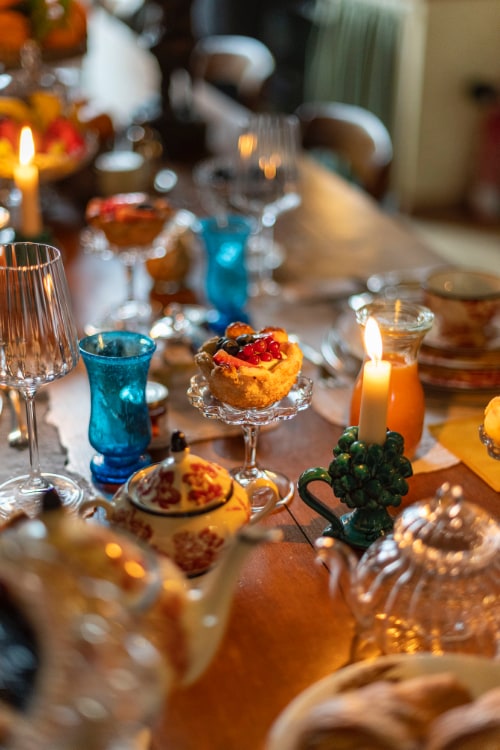 And the breakfast! La cucina, under the supervision of the couple’s playful black and blonde Labrador sisters, Ortensia and Olivia, is the rustic centre of activity in the mornings. Jams and jellies made from the garden’s abundance, heavenly cappuccinos, the freshest eggs and prosciutto, cheeses, cream puffs and tarts (hmmm, maybe walking up and down the bridge is a good idea,) are all presented on decorative china and vintage glassware. Hazelnuts on the table we learn, are grown in the nearby valley for Ferrero Rocher, makers of those luscious gold covered chocolates and Nutella. One morning Melis surprised us by setting up breakfast on a pink hand-printed Lisa Corti tablecloth, the table under the wrought iron gazebo in the courtyard. “ How in the world did they get it up the mountain,” I ask dumbfounded. “The gazebo had to be brought up the bridge in sections and reassembled piece by piece,” Melis explained.
And the breakfast! La cucina, under the supervision of the couple’s playful black and blonde Labrador sisters, Ortensia and Olivia, is the rustic centre of activity in the mornings. Jams and jellies made from the garden’s abundance, heavenly cappuccinos, the freshest eggs and prosciutto, cheeses, cream puffs and tarts (hmmm, maybe walking up and down the bridge is a good idea,) are all presented on decorative china and vintage glassware. Hazelnuts on the table we learn, are grown in the nearby valley for Ferrero Rocher, makers of those luscious gold covered chocolates and Nutella. One morning Melis surprised us by setting up breakfast on a pink hand-printed Lisa Corti tablecloth, the table under the wrought iron gazebo in the courtyard. “ How in the world did they get it up the mountain,” I ask dumbfounded. “The gazebo had to be brought up the bridge in sections and reassembled piece by piece,” Melis explained.
Imagine watching Fellini’s La Dolce Vita, glass of wine in hand, in the cavernous stone Wolf’s Lair, a cozy hideaway with enormous fireplace. Once the ancient cistern, now converted into a home theatre, it’s filled with books, games, a Forneris piano and of course a large film screen.
Venturing out of Corte della Maestà for dinner we were delighted at the number of restaurants off the main piazza. They receive fresh produce supplies almost daily from moped deliveries. Osteria Al Forno di Adnese and Alma Civita not only served delicious specialties, but, to our surprise we met several fellow Canadians dining there.
Corte della Maestà is truly the bridge between past and present – a heavenly retreat from our daily lives.
IF YOU GO:
Corte della Maestà is located in the mountain village of Civita di Bagnoregio. The train stops at nearby Orvieto. From Rome it’s about 90 minutes. If you drive, there is parking at the beginning of the bridge or Cristiana Melis can arrange for a driver to pick you up at Orvieto Station. cortedellamaesta.com

